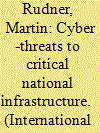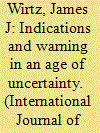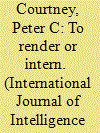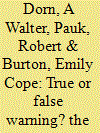|
|
|
Sort Order |
|
|
|
Items / Page
|
|
|
|
|
|
|
| Srl | Item |
| 1 |
ID:
122918


|
|
|
|
|
| Publication |
2013.
|
| Summary/Abstract |
Despite the potentially horrific implications of failure, counterintelligence (CI) is often viewed as the stepchild of the United States Intelligence Community (IC). The assertion has often been that CI in the U.S. has never worked due to the American culture and its frequent association with "mere" security. This was made even worse in many cases by the IC's shift from a counterespionage posture to a counterterrorism focus after the 11 September 2001 (9/11) attacks, 2 thereby creating unique challenges for CI managers. Unfortunately, relatively little focus has been placed on providing CI managers with useful ways to conceptualize and meet the unique day-to-day challenges they face.
|
|
|
|
|
|
|
|
|
|
|
|
|
|
|
|
| 2 |
ID:
122912


|
|
|
|
|
| Publication |
2013.
|
| Summary/Abstract |
Cyber attacks directed at Critical National Infrastructure constitute a significant, diverse, and rapidly escalating risk-element in the global threat environment. Critical infrastructures are susceptible to cyber attacks precisely because of their high inherent value and intrinsic vulnerabilities, coupled with a significant potential to inflict widespread harm on targeted countries. Threats to the cyber-security of critical infrastructures emanate from a wide spectrum of prospective perpetrators: state-sponsored espionage and sabotage, international terrorism, domestic militants, malevolent "hacktivists," or even disaffected insiders. Thus, British intelligence sources indicate that the United Kingdom is being bombarded by thousands of cyber attacks daily, perpetrated by hackers and state-sponsored organizations targeting government and business so as to steal secrets or disable networked computerized systems. 1 While criminal elements can also pose a threat to cyber-security, they tend to be motivated by material or financial benefit, whereas the focus here is exclusively on cyber-attacks perpetrated on Critical National Infrastructures to promote political or ideological objectives.
|
|
|
|
|
|
|
|
|
|
|
|
|
|
|
|
| 3 |
ID:
122916


|
|
|
|
|
| Publication |
2013.
|
| Summary/Abstract |
Indications and warning intelligence is an important and time-tested methodology employed by intelligence analysts to warn military officers and policymakers about changes in an opponent's operational "posture" which indicate that the likelihood of dangerous or aggressive activity is increasing. In recent times, it has fallen out of fashion because policymakers and the public alike have come to expect that the Intelligence Community will be able to provide "specific event predictions" of an opponent's future actions. In other words, people tend to believe that intelligence analysts should be able to state who is about to undertake some unwanted activity, as well as where, how, when and why the action will unfold.
|
|
|
|
|
|
|
|
|
|
|
|
|
|
|
|
| 4 |
ID:
122915


|
|
|
|
|
| Publication |
2013.
|
| Summary/Abstract |
The massive amount of scientific and popular literature in the emerging field of "theory of intelligence" published over the past decades has been dedicated to analyzing the effects of intelligence organizations and their products in the political decisionmaking process. Different facets of the phenomenon are covered by using various analytical vehicles since a thorough analysis of its perplexities requires a multidisciplinary approach that includes expertise not only in political science but in sociology, psychology, history, and organizational and business management studies.
|
|
|
|
|
|
|
|
|
|
|
|
|
|
|
|
| 5 |
ID:
122919


|
|
|
|
|
| Publication |
2013.
|
| Summary/Abstract |
Intelligence analysts spend a good deal of time discussing accuracy in forecasting and they should. Saying accurate things about the future is arguably much more valuable to decisionmakers than saying accurate things about the present or past. Doing so is also inherently more difficult.
Even when trying to say accurate things about the future, though, some questions are easier for analysts to answer than others. Why? What are the essential elements of a question that make it obviously more or less difficult to answer? How can these criteria be generalized across all questions?
Intelligence professionals are not the only ones to recognize the inherent difficulties in different kinds of questions. Michael V. Hayden, the former Director of both the Central Intelligence Agency (CIA) and the National Security Agency (NSA), delights in telling this story:
Some months ago, I met with a small group of investment bankers and one of them asked me, "On a scale of 1 to 10, how good is our intelligence today?" I said the first thing to understand is that anything above 7 isn't on our scale. If we're at 8, 9, or 10, we're not in the realm of intelligence-no one is asking us the questions that can yield such confidence. We only get the hard sliders on the corner of the plate. 1
|
|
|
|
|
|
|
|
|
|
|
|
|
|
|
|
| 6 |
ID:
122917


|
|
|
|
|
| Publication |
2013.
|
| Summary/Abstract |
In recent years, the Intelligence Community has been rather infatuated with positivist social science. Analysts like Stephen Marrin and Gregory Treverton have suggested that the best way for practitioners to reform intelligence analysis (and indeed the whole intelligence cycle) is to borrow positivist methodologies such as evidence-based practices and hypothesis testing from academic scientists and social scientists. Here, analysts seem particularly drawn to making analogies with the medical profession. The constraints which practitioners face and the methodologies they use in making an assessment or diagnosis are frequently compared. For example, Gary McClelland noted that:
Just as physicians often have to make quick assessment based on limited and sometimes conflicting information sources with no two cases ever being quite the same, so too intelligence analysts evaluate and characterize evolving situations using partial information from sources varying in credibility. 1
|
|
|
|
|
|
|
|
|
|
|
|
|
|
|
|
| 7 |
ID:
122913


|
|
|
|
|
| Publication |
2013.
|
| Summary/Abstract |
On 28 May 2009, the Los Angeles Times reported that the United States Department of Justice and the Federal Bureau of Investigation (FBI) planned to significantly expand their role in global counterterrorism operations, as part of a policy shift that would replace the Central Intelligence Agency (CIA)-dominated system of clandestine detentions and interrogations with one built around transparent investigations and prosecutions. This new "global justice" initiative has created a more central role for FBI agents in overseas counterterrorism cases, and harkens back to the FBI's Special Intelligence Service (SIS). In 1940, President Franklin D. Roosevelt had requested the creation of the SIS that served as the Bureau's foreign intelligence and counter-subversive wing in Latin and South America until its disbandment in 1947.
|
|
|
|
|
|
|
|
|
|
|
|
|
|
|
|
| 8 |
ID:
122914


|
|
|
|
|
| Publication |
2013.
|
| Summary/Abstract |
The success of the Namibian independence plan in 1989-1990 is a high point in the history of the United Nations (UN). The enormous challenge of Namibia even predated the organization, going back seven decades on the international agenda. South West Africa (Namibia) became a mandate under the League of Nations in 1920 after Germany lost that colonial territory to the then Union of South Africa during World War I. After World War II, the mandate continued as a UN trusteeship under South Africa, but Pretoria refused to accept the required international supervision. It governed Namibia as a colony, complete with the brutal racist institution of apartheid. In 1963, its trusteeship was officially terminated by the UN Security Council and, in 1966, the UN General Assembly declared that South Africa's continued control of Namibia was illegal. Then, in 1978, in a push for Namibian independence, the Security Council unanimously passed Resolution 435 (1978), which outlined an implementation strategy for free elections. But another ten years elapsed before the United Nations and the United States gained South Africa's cooperation.
|
|
|
|
|
|
|
|
|
|
|
|
|
|
|
|
|
|
|
|
|